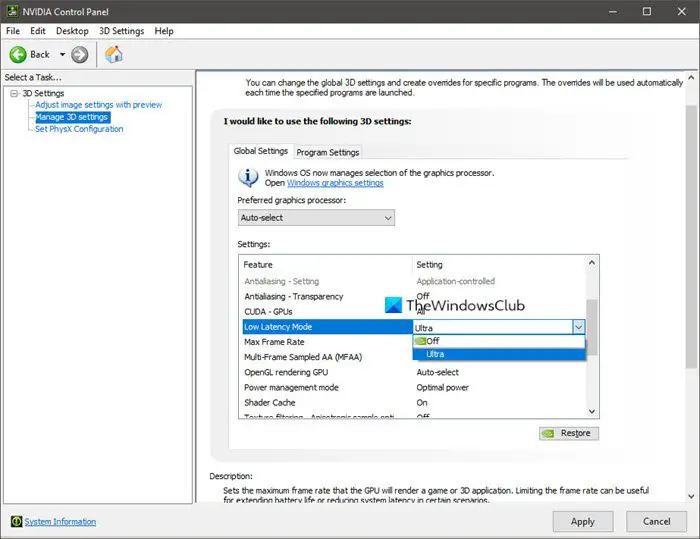NVIDIA’s graphics driver now has a new feature called NVIDIA Ultra Low Latency mode, which is intended for competitive gamers and those who want to leverage the fastest input response in their games. The NVIDIA low latency mode feature would be available for all NVIDIA GeForce GPUs in the NVIDIA Control Panel. In this post, we will show you how to enable NVIDIA Low Latency Mode on Windows 11/10.
Before we jump right into it, a bit of background.
According to NVIDIA;
With “Ultra-Low Latency” mode, frames are submitted into the render queue just before the GPU needs them. This is “just in time frame scheduling,” and it will “further [reduce] latency by up to 33%” over just using the Maximum Pre-Rendered Frames option.
This works with all GPUs. However, it only works with DirectX 9 and DirectX 11 games. In DirectX 12 and Vulkan games, “the game decides when to queue the frame” and the NVIDIA graphics drivers have no control over this.
Low Latency modes have the most impact when your game is GPU bound, and framerates are between 60 and 100 FPS, enabling you to get the responsiveness of high-frame-rate gaming without decreasing graphical fidelity. If a game is CPU bound (that is limited by your CPU resources instead of your GPU) or you have very high or very low FPS, enabling this setting won’t improve your experience. Also, if you have input latency in games, mouse lag, that’s often simply a result of low frames per second (FPS) and this setting won’t solve that problem.
Read: What is Gaming Lag, Low FPS in video games and how to fix them?
Enable NVIDIA Low Latency Mode

To enable NIVIDIA low latency mode on Windows 11/10, do the following:
You’ll need the latest NVIDIA graphics driver to take advantage of this feature. You can update your graphics driver through the GeForce Experience application or download the latest graphics driver directly from NVIDIA’s website. Once done, continue as follows:
- Right-click on the desktop of your computer and then choose NVIDIA Control Panel.
- In the pop-up window, click Manage 3D settings from the left panel to continue.
- Now, you need to decide how to enable NVIDIA low latency mode.
- If you want to enable it for all games, select Global Settings.
- If you want to enable it for one or more specific games, select Program Settings and choose the game you want to enable.
- Then select Low Latency Mode in the list. Choose Ultra in the setting list on the right. The ultra setting submits the frame just in time for the GPU to pick it up – there will be no frame setting in the queue and waiting.
- Next, click Apply button to save your settings.
You can now close the NVIDIA Control Panel.
Read: How to use NVIDIA Reflex to fix Low Latency in games
Note: Enabling NVIDIA’s low latency mode will potentially reduce your FPS. This mode is off by default, which leads to “maximum render throughput.” For most people, that’s a better option. But, for competitive multiplayer gaming, you’ll want all the tiny edges you can get—and that includes lower latency.
If you want to disable the NVIDIA low latency mode and use the NVIDIA graphics driver’s default settings, just return the page and click Restore.
TIP: This post will help you if NVIDIA Low Latency Mode is not showing up on Windows 11/10.
Leave a Reply